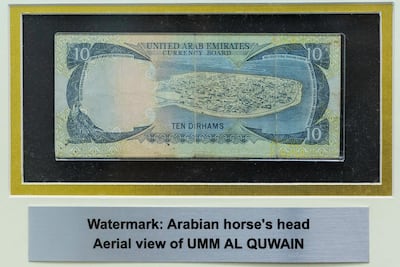The UAE's currency was introduced on May 20, 1973, a little over two years after the country was formed.
Prior to the dirham, the rupee, dinar and even the Maria Theresa silver thaler were used.
In this weekly series, The National breaks down the historical and cultural significance of the designs for each of the dirham denominations.
Dh10
First issued in 1973, the original Dh10 banknote would be unrecognisable today. Printed in dark grey ink on a background mostly of shades of pale green, the Arabic face carried the composite mark of a sailing dhow and the outline of the UAE Gulf coast above a line of camels, and framed with a palm tree, oil derrick and a string of pearls.
The English side was printed with an aerial image of Umm Al Quwain, with the words “United Arab Emirates currency board".
In 1982, the Dh10 note was replaced with the design familiar today, with images that reflect aspects of life and culture. The Arabic face features a khanjar, the carved dagger worn by Emirati men at ceremonies. The central watermark includes the crest of the UAE, with the spread wings of the Hawk of Quraish, the tribe of the Prophet Mohammed.
On the reverse, the English language face is a composite of a farm, complete with rows of crops alongside trees and date palms. In the foreground is the crown of a date palm, laden with ripe fruit. Each side is a powerful statement of the importance of tradition and the bounty of nature in Emirati culture, both close to the heart of Sheikh Zayed.
Ensuring sustainable agriculture was one of the main goals of Sheikh Zayed, who said: "Provide me with sustainable agriculture, I will ensure you a civilised society."
The Dh10 has been reissued many times since then, most recently in 2017 with some changes, including the font of the Arabic script and enhanced security, but at heart remains as timeless as the way of life it commemorates.






















